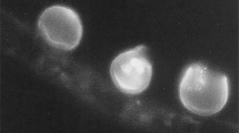

 Cryptogamie, Algologie
27 (2) - Pages 165-184
Cryptogamie, Algologie
27 (2) - Pages 165-184The 18 S rRNA genes of Eurychasma dicksonii and Chytridium polysiphoniae, pathogens of brown algae, were sequenced and used to clarify their phylogenetic affiliations. E. dicksonii is consistently placed at the base of the Peronosporomycota (Oomycota) with high bootstrap support. Nevertheless, its sequence is clearly separated from other terrestrial and freshwater Oomycota. The closest related marine group is a clade entirely composed of environmental sequences retrieved from marine sediments and oceanic plankton samples. The genus Chytridium usually forms a clade that includes several other genera (alongside the clades of Monoblepharis-, Rhizophydium-, Lacustromyces-, Nowakowskiella-, Neocallimatix- and Spizellomyces-like organisms) within the Chytridiomycota, one of the principal lineages of the Eumycota. Interestingly, our sequence of C. polysiphoniae differs drastically from others sequences of the genus Chytridium, forming a novel clade of the Chytridiomycota, which also includes environmental sequences from water and soil samples. Consistent with these phylogenetic affiliations, C. polysiphoniae has a chitin cell wall, whilst E. dicksonii has cellulose. Together, these results suggest that Eurychasma and Chytridium may become interesting model organisms as the currently only culturable and morphologically known representatives of a poorly understood aquatic biodiversity, pointing out the necessity to include marine representatives for phylogenetic studies of the Oomycota and Chytridiomycota.